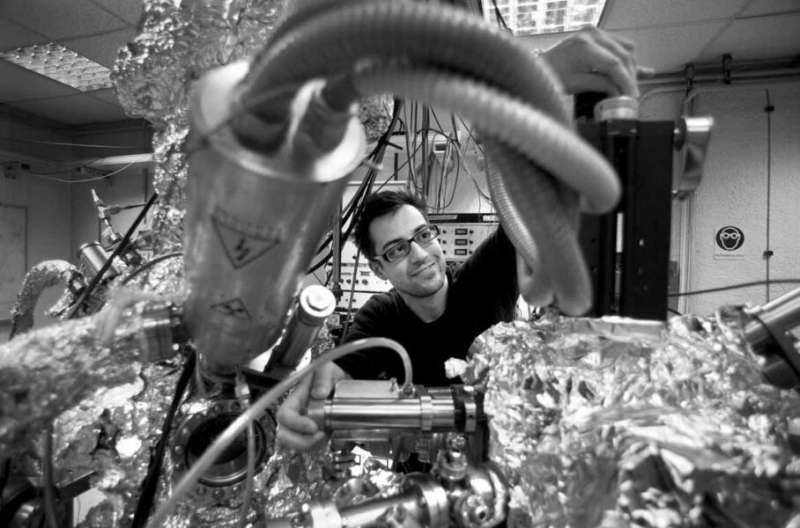A conceptual image that features a spin current (green spheres) injected into a crystal of GeTe on a silicon wafer. Depending on the orientation of the ferroelectric polarization in GeTe (faded orange and light blue atoms), the output charge current is either positive (+) or negative (-). Germanium telluride can be monolithically integrated with silicon, paving the route for the development of reconfigurable devices on silicon technology. Credit: Varotto et al.
Spintronic devices, a class of architectures that can store or transfer information by leveraging the intrinsic spin of electrons, have been found to be highly promising, both in terms of speed and efficiency. So far, however, the development of these devices has been hindered by the poor compatibility between semiconducting materials and ferromagnetic sources of spin, which underpin their operation.
In fact, while some semiconductors can generate electrical currents from transverse spin currents and vice versa, reliably controlling this spin-charge conversion has so far proved to be highly challenging. In recent years, some material scientists and engineers have thus been investigating the potential of fabricating spintronic devices using ferroelectric Rashba semiconductors, a class of materials with several advantageous properties, such as semiconductivity, large spin-orbit coupling and non-volatility.
A team of researchers at Politecnico di Milano, University Grenoble Alpes and other institutes worldwide have recently demonstrated the non-volatile control of the spin-to-charge conversion in germanium telluride, a known Rashba semiconductor, at room temperature. Their paper, published in Nature Electronics, could have important implications for the future development of spintronic devices.
The Rashba effect, discovered in 1959, entails a momentum-independent splitting of spin bands in two-dimensional condensed matter systems. In ferroelectric Rashba semiconductors, this effect can be reversed by switching the direction of the ferroelectric polarization.
The idea that Rashba spin-splitting in these materials can be controlled was confirmed by a series of first-principle calculations by S. Picozzi and later validated in spectroscopic experiments using germanium telluride, which is thus often considered the 'prototype' of the ferroelectric Rashba class of semiconductors.
"Thanks to this one-to-one relationship between ferroelectric state and spins, an electric field able to switch the ferroelectric polarization would enable the non-volatile control of spin transport," Christian Rinaldi, one of the researchers who carried out the study, told TechXplore. "In 2019, S. Manipatruni and I. Young from Intel published a very inspiring piece of work to exploit spin-based electronics for ultralow power consuming devices. Intel saw in spintronics efficiency and density scaling far beyond actual CMOS technology."
The architecture introduced by Intel in 2019, dubbed MESO, can store information in the magnetization of a nanomagnet. Subsequently, it processes this information via spin-to-charge conversion in other materials.
Conventional electronic devices process information and read it using electric charge and voltage. Spin-based electronics, on the other hand, exploit spinning electrons to carry information. The term 'spin-to-charge conversion' essentially refers to the ability of materials to bridge the use of electric charge for information processing with the use of electron spins. In other words, spin-to-charge conversion allows spin currents to be converted into voltages, allowing electronic devices to read out information easily.
Credit: Varotto et al.
"When I reviewed Intel's solution, I realized immediately that germanium telluride could have made the difference, provided that the non-volatile direction of the ferroelectric polarization could modify the spin-to-charge conversion of the compound," Rinaldi said. "Such mechanism would have allowed to store information in the ferroelectric, process it using the spin and then translate the result into measurable voltage. This was the key to enable architectures beyond-CMOS with ultra-low power consumption and a potentially great simplification of the Intel's architecture."
To demonstrate the ferroelectric control of the spin-to-charge conversion, Rinaldi and his colleagues first had to show that controlling ferroelectricity in germanium telluride by applying voltage pulses to metallic contacts deposited on the semiconductor was possible. Subsequently, they injected spin-currents into germanium telluride and measured the resulting charge current, comparing it to the polarization state.
"We demonstrated the ferroelectric gating of the semiconductor by applying voltage pulses through a thin metallic gate on top of germanium telluride," Sara Varotto, a Ph.D. researcher who carried out the study, explained. "We mapped the distribution of ferroelectric domains underneath the gate using the conductive tip of an atomic force microscope. We also discovered a link between the ferroelectric domains configuration and the electric resistance of metal/germanium telluride junctions, a very effective way to easily access to the polarization state."
Varotto subsequently performed a series of spin pumping experiments at University Grenoble Alpes, under the supervision of researchers Laurent Vila and Jean-Philippe Attané. The team excited an iron layer in contact with the germanium telluride sample to inject a spin current into the semiconductor. These experiments revealed that spinning electrons are deflected to the left or right by germanium telluride, depending on the direction of the ferroelectric polarization.
"We reveal that spin Hall effect is responsible for this conversion from spin to charge currents in germanium telluride, thanks to the precious work of Jagoda Slawinska and Marco Buongiorno Nardelli from University of North Texas," Rinaldi said. "A similar non-volatile electric control of spin-charge conversion has also been demonstrated in oxides-based two-dimensional electron gas. A very significant discovery, so far limited by the fact that the system works at cryogenic temperatures, in materials potentially difficult to integrate on silicon."
This team of researchers is the first to demonstrate ferroelectric switching of the spin-to-charge conversion at room temperature in a semiconductor that could be monolithically integrated on silicon. This is a notable achievement compared to past efforts.
"We also proposed a conceptual logic device that shares the favorable scaling law and low power consumption with Intel's MESO device, but with a great overall simplification offered by the fact that germanium telluride has both memory and spin transduction capabilities in the same material, thereby eliminating complex solutions to write the information," Rinaldi said. "Similarly to what happens in our brain, the memory and the computation reside in the same physical space, with perspectives in in-memory computing."
In the future, the strategy for controlling spin-to-charge conversion in germanium telluride proposed by Rinaldi and his colleagues could be applied to the development of new spintronic devices. Moreover, as the device they theoretically proposed in their paper can store and process information in the same physical space, similarly to the human brain, it could prove particularly useful for in-memory computing applications.
"My research focuses on spin-based solutions in novel quantum materials to help the development of a new computing era," Rinaldi added. "The first step in this sense will comprise material engineering of ferroelectric Rashba semiconductors to bring such compound much closer to technology."
More information: Sara Varotto et al, Room-temperature ferroelectric switching of spin-to-charge conversion in germanium telluride, Nature Electronics(2021). DOI: 10.1038/s41928-021-00653-2
Domenico Di Sante et al, Electric Control of the Giant Rashba Effect in Bulk GeTe, Advanced Materials (2012). DOI: 10.1002/adma.201203199
Christian Rinaldi et al, Ferroelectric Control of the Spin Texture in GeTe, Nano Letters (2018). DOI: 10.1021/acs.nanolett.7b04829
Sasikanth Manipatruni et al, Scalable energy-efficient magnetoelectric spin-orbit logic, Nature(2018). DOI: 10.1038/s41586-018-0770-2
Paul Noël et al, Non-volatile electronic control of spin-charge conversion in a SrTiO3 Rashba system, Nature (2020). DOI: 10.1038/s41586-020-2197-9
Journal information: Nature Electronics , Nano Letters , Nature , Advanced Materials
© 2021 Science X Network

























